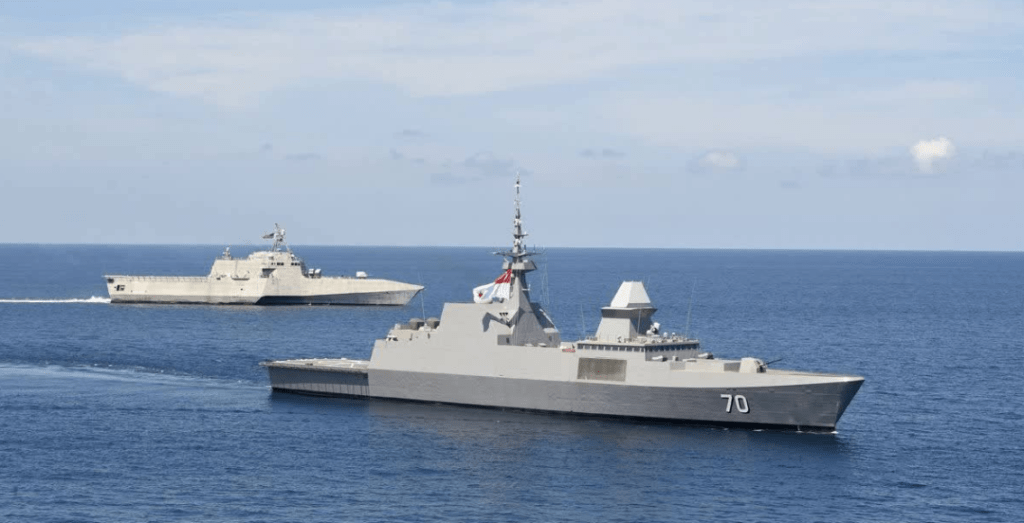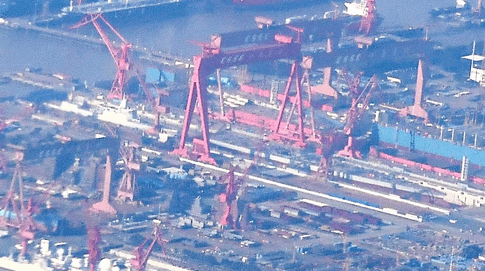This week, there is a lot of news about the navy: the U.S. Navy’s aircraft carrier “Roosevelt” officially set out for its second cruise deployment in 2020 after half a month of dock quarantine; the U.S. Navy began to consider the establishment of a first ship in Australia-centered waters. The new formation of the team; the U.S. media exposed the official recognition of the U.S. military’s claim that China’s anti-ship ballistic missiles were successfully tested; France and China’s new generation of aircraft carriers have also made their own progress in the construction.
In the era that is about to pass in 2020, several major countries are making their own intense preparations around the world maritime power competition in the era of great power competition.
U.S. Navy West Pacific Rearrange
On December 7, the aircraft carrier strike brigade with the aircraft carrier Roosevelt as the core left the port of San Diego and began its overseas cruise deployment. As an aircraft carrier based on the west coast of the United States, this deployment is unusual in terms of cycle – in the post-Cold War nuclear aircraft carrier era, after completing cruise deployment and returning to the mainland, the U.S. aircraft carrier usually needs to carry out incremental maintenance works for at least 10 months, plus subsequent crew retraining.
Working, it often takes more than a year to restore deployability. Therefore, except for the aircraft carrier deployed once a year in Yokosuka, Japan, the U.S. aircraft carriers on the east and west coasts are generally deployed every other year. But Roosevelt just returned to the mainland of the United States in July this year, less than half a year before the new deployment.

One of these factors is certainly related to the impact of the coronavirus epidemic on Roosevelt’s last cruise deployment. After the last deployment of “Roosevelt” left the mainland of the United States in January, it contracted and spread the COVID-19 epidemic on the aircraft carrier in March, which once led to more than one-fifth of the aircraft carrier crew members who were diagnosed positive.
Although the senior management of the U.S. military hoped that the ship could overcome the epidemic and continue to carry out deployment tasks, the then captain of the ship Captain Brett Crozier revealed the epidemic on the aircraft carrier, forcing the U.S. Navy to order the ship to dock in Guam on March 31 and isolate the infected people on board for treatment.
Although Roosevelt, which returned to the sea on May 21, then carried out some cruise missions and spent more than half a year overseas, the ship actually only deployed at sea for about four and a half months, and did not need 10 in terms of the wear and tear of the ship or the actual time of the crew.
Months of incremental repair. Considering that the aircraft carrier Nimitz, which could have been deployed in 2021, has been deployed ahead of 2020, allowing Roosevelt to cruise after a short rest is indeed a way to “atone for” her sudden absence in 2020.

In this “back-to-back” deployment form, the value of the front aircraft carrier home port, or logistics support base with certain capabilities, is particularly obvious. It is also about half a year of repair and maintenance and then put into cruise.
At present, the operation of the aircraft carrier Reagan, the home port located in Yokosuka, is generally half a year’s maritime cruise, and half a year of maintenance in the port.
Because the home port itself is located in the waters of the West Pacific, the aircraft carrier almost enters the mission waters as soon as it leaves the port; and “Rose For aircraft carriers located on the west coast of the United States, such as Fuku, will take about a month to sail to the waters of the West Pacific, and at least half a month after more than half a cruise mission, it will take at least half a month to return to its home port.
Although the aircraft carrier crew and the strike brigade itself will not be idle during these times, and will carry out a series of training and exercise activities, from a mechanical point of view, it is not necessary for the U.S. Navy, which currently has the aircraft carrier to spend nearly two months of mechanical life during the voyage of the aircraft carrier.
It seems somewhat wasteful to return home to major activities such as nuclear fuel replacement.

It is based on this consideration that another thing that the U.S. military has recently made a voice to consider is more noteworthy.
On December 4, several media reported that a spokesman for the Secretary of the United States Navy confirmed that in order to meet the high-level response of the U.S. government to China’s rapid military strength, the U.S. Navy is considering reorganizing the First Fleet, saying that the decision has reached the final stage, implying that the fleet will soon.
The establishment of the system may become a reality. According to the U.S. military, the First Fleet should be responsible for the waters bordering the Indian Ocean and the Pacific Ocean. Considering the current jurisdiction of the Seventh Fleet, the First Fleet is likely to take Singapore as its important operating base and command the U.S. naval forces in the Indian Ocean.

Historically, the First Fleet of the United States Navy was not long. It was established in 1947 to cover part of the Pacific waters. It was withdrawn in the 1973 fleet adjustment and its mandate was also entrusted to the current Third Fleet.
In the U.S. Navy, the fleet is mainly responsible for command and operation, while the planning and development of shipbuilding is the responsibility of the Admiralty.
From this perspective, although the formation of the First Fleet means the unquestioned attention and targeted strength of the U.S. Navy to China, this adjustment of command will also increase the vacancy, including a lieutenant general commander, and give the middle and senior officers of the U.S. Navy an additional professional direction, but it will not be conjured out of thin air. More surface ships.
At present, the U.S. Navy has deployed 60% of its naval forces in the Pacific Ocean. Further tilting to the Pacific Ocean naturally requires tearing down the east wall to make up the west wall, considering that the U.S. Navy is currently in a state of constant shortage of ready-to-use aircraft carriers in the Atlantic direction, plus the Mediterranean, Europe and Africa. The geopolitical pattern of the United States is also in a state of change at present.
Although the U.S. Navy is still operable to further strengthen its power in the Asia-Pacific region, there is little room in terms of the size of the existing fleet.

In terms of diving direction for the existing force, with F-35B fighter aircraft gradually joining the U.S. Navy Amphibious Reinforcement Group in recent years, and accompanying the cruise deployment of amphibious attack ships, the U.S. Navy’s practice of adding amphibious attack ships to cruises as auxiliary aircraft carriers has gradually taken shape.
Compared with the U.S. military during the Iraq War, which used amphibious attack ships as “incarriers” to undertake close ground support tasks, the combination of F-35B and amphibious attack ships is quite strong due to the leapfrogging performance of the fighter aircraft. Both their anti-aircraft interception ability and attack capabilities are quite strong.
Judging from the performance of carrier-based fighter aircraft, It is most powerful than the carrier-based aircraft in active service of several naval powers, including China, Russia and France.
Although the U.S. Navy lost the amphibious assault ship “Goodman Richard” this year, and its shipbuilding plan seems difficult to make up for this short time, the bulk entry of the F-35B can amplify the attack capability of its amphibious attack fleet.
Although amphibious attack ships have shortcomings such as relatively insufficient command and control capabilities and lack of dedicated early warning aircraft compared with regular aircraft carriers, the U.S. military can use other early warning aircraft and command forces, including in the theater to support them.
Although such support is difficult to guarantee full-time, it has been operating in the Asia-Pacific region for many years. For the U.S. military, it is obviously not difficult to let amphibious attack ships act as a light aircraft carrier when cruising in this area. Of course, bringing more F-35B means bringing fewer helicopters and MV-22s, and its ability to carry out traditional amphibious operations will naturally be affected.
However, for the U.S. military in the western Pacific Ocean, if even maritime air supremacy cannot be guaranteed, the amphibious landing combat capability is not important.

As a country that is still in the leading position in the field of naval technology in the world, the adjustment of naval power deployment of the United States emphasizes the position and scale of combat power, while for many other countries, further technologically, sometimes more important content.
Large aircraft carrier with more than 70,000 tons
This week, French President Macron announced that France will design and build a new nuclear-powered aircraft carrier to replace Charles de Gaulle, France’s only aircraft carrier in active service, around 2038.
According to the information disclosed so far, the displacement of the new aircraft carrier will far exceed that of the active Charles de Gaulle, reaching more than 70,000 tons, equipped with two elevators and three electromagnetic catapults, and carrying the next generation of French fighter jets and drones.
This project is the PANG aircraft carrier project that began to be launched in 2018.

There is a quite important subtext behind this news, which most media reported did not pay much attention to, that is, France officially abandoned its “hoenship” of owning two aircraft carriers and began to set up a single aircraft carrier as the core of the French navy to plan the next generation of French maritime power.
Although France had aircraft carriers as early as before World War II, the construction of its naval force with aircraft carriers as the core did not begin until the end of World War II.
Relying on aircraft carriers leased from Britain and the United States, France once had three aircraft carriers at the same time, but neither of them could carry jet carrier-based aircraft; in France built two of its own. After the “Clermonseau”-class aircraft carrier, the French navy has completely entered the jet era, but after the leased aircraft carrier is retired, the number of aircraft carriers of the French navy has dropped to two.
Throughout the Cold War, France had planned to build additional aircraft carriers at least twice, increasing the number of aircraft carriers of the French Navy to more than three, but ultimately failed to materialize due to budgetary problems.” The aircraft carrier Charles de Gaulle was originally planned not only to build one, but two, replacing two “Clermonseau”-class ships.
However, due to the high cost of the former, the French navy finally decided to build only one.
In the following years, France was still trying to rebuild an aircraft carrier and restore the size of the French navy to two aircraft carriers. The most representative of these is that before and after the development of the Queen Elizabeth class in the United Kingdom, the French navy drew heavily on the “inspired” of the British aircraft carrier program and proposed the PA2 aircraft carrier plan, using the Gauge power to try to reduce the cost, while enlarging the tonnage to try to improve performance.
Of course, the final result is still that heroes and heroes are still difficult to defeat at a penny.
The French navy has not made up its mind to allocate enough funds for the construction of a second aircraft carrier. With the longer and longer service of the aircraft carrier Charles de Gaulle, France’s second aircraft carrier plan has now become France’s next aircraft carrier plan.

Judging from the design of the new aircraft carrier, the French navy’s experience and lessons in the use of Charles de Gaulle are reflected in its overall layout.
As the only newly built traditional medium-sized aircraft carrier in the world at the end of the last century, the overall layout was quite “balanced” at that time, but it was also considered to have the unique consideration of the French navy.
Under the overall rectangular bevel deck layout, the island of Charles de Gaulle is quite forward. The purpose is to use the tall island to block the wind and waves in front of it, so as to facilitate the rear two elevators to carry out carrier-based aircraft lifting operations, and improve the forward vision of the aircraft carrier during navigation; and the price paid is the aircraft carrier.
The parking area in front of the island is almost zero, so that after recycling the carrier-based aircraft, all aircraft have to be moved to the front flight deck, completely cutting off the possibility of taking off and landing the aircraft carrier at the same time.
The island of the new aircraft carrier is similar to the “Ford” class of the United States Navy, very close to the stern, leaving two elevators in front of the island, at the cost of weakening navigational observations, increasing the parking area of the front deck in order to park the larger French next generation of carrier aircraft, and handing the responsibility of resisting wind and waves to the higher deck.
Position, thus increasing the number of ship-based aircraft recycled at the same time, and allowing aircraft carriers to take off and land on board aircraft at the same time. All of this is based on a simple and simple lesson summarized by France based on the history of the unsuccessful use of Charles de Gaulle: large-ton aircraft carriers have great benefits.



For aircraft carrier design, controlling tonnage can effectively control the scale of the power system required by aircraft carriers and reduce the requirements for the number of relevant facilities on board, thus reducing the complexity of design and construction difficulty, while reducing the construction cost of aircraft carriers to a certain extent.
However, with the increasing size of contemporary carrier-based aircraft themselves, the “bottom line size” required to operate carrier-based aircraft, especially conventional take-off and landing aircraft, has also risen: “In the late 1950s, where the Clermonseau design is located, medium-sized aircraft carriers only need carrier-based aircraft that can take off less than 15 tons; when it comes to design, “wear” At the time of Gaulle, even the self-restrained “medium fighter” had a take-off weight of 25 tons; as for the next generation of carrier-based aircraft, the single-engine F-35C has reached more than 30 tons, and the size and take-off weight of the two-engine heavy fighter are obviously only large.
In addition, the effective dispatch of carrier-based aircraft on aircraft carriers requires large-scale flight decks and hangars, and the huge amount of fuel, ammunition and spare parts required to sustain the operation of the aircraft also require a larger hull to carry…
It will cost more to enlarge the aircraft carrier, but if you only consider the construction cost and ignore the aircraft carrier, it needs to be operated. If you want to do the task, then the final payment will be more than just more money.

A similar situation happened in the design of the new generation of aircraft carriers of several other naval powers. Although the two British Queen Elizabeth class still use short take-off/vertical landing carrier-based aircraft, their tonnage has been comprehensively increased.
Through a large hull of nearly 70,000 tons, the aircraft carrier’s ability to carry out all aspects of tasks is improved as much as possible within the capacity of the British shipbuilding industry.
Although China has just joined the ranks of countries that built aircraft carriers for a few years, and the tonnage of the first aircraft carrier and the first domestic aircraft carrier has also reached 50,000 tons, due to the larger take-off weight and deck area used by the J-15 heavy carrier-based fighter aircraft used by the Chinese navy, China’s next generation of aircraft carriers has also It quickly embarked on the road of further expanding the scale and tonnage of aircraft carriers.
Judging from the images of the next aircraft carrier circulating on the Internet, although we can’t accurately estimate the displacement of this aircraft carrier, judging from the length of its hull beyond the waterline of the two existing Chinese aircraft carriers, the ship will be further expanded on the main scale, so that while carrying multiple electromagnetic catapults, it can It is enough to increase the area of the flight deck and hangar, optimize the scheduling of carrier-based aircraft, and cooperate with the new generation of carrier-based fighters to increase the aircraft carrier’s aircraft capacity and combat capability.

Of course, a larger aircraft carrier means more difficulty and cost of construction, and for France, which is already limited in military expenditure and naval size, this naturally means that the goal of the dual aircraft carrier navy pursued by the French navy for many years is even more impossible to achieve.
Although the combat capability of the French navy will certainly be strengthened with the entry into service of the new aircraft carrier, the inability to change the situation of a single aircraft carrier makes the problem that plague France’s current military diplomacy still unsolved: how to deal with France’s foreign policy can make France perform tasks and unable to carry out in the only aircraft carrier. In the task, can it equally effectively safeguard France’s national interests?



